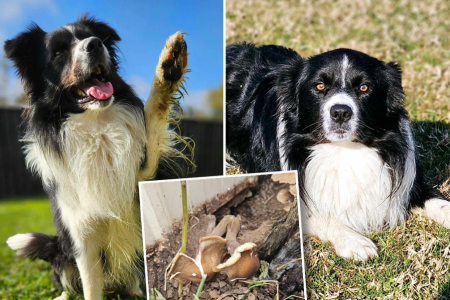How one backyard fungus left a family $4,600 out of pocket—and it could happen to you
By
Maan
- Replies 0
Unusual pet behaviour can be worrying, especially when the cause isn't immediately clear.
One Aussie dog owner's experience took a frightening turn after her beloved pet suddenly began acting out of character.
What followed was a costly and confusing ordeal that left her searching for answers in the most unexpected place—her own backyard.
An Australian pet owner has sounded the alarm after her border collie suffered a terrifying health episode triggered by a common backyard fungus.
Tara Cheslett, from the Southern Highlands of New South Wales, said her three-year-old dog Flash began acting strangely on a Saturday morning, appearing ‘wobbly’ and ‘dazed and confused’ when she brought him inside.
She rushed him to the vet as his condition worsened, describing his symptoms as both ‘confusing’ and concerning.
‘He was unbalanced...and he was unable to empty his bladder,’ Tara shared.
‘His penis was spasming...it actually looked like someone had drugged him....it was all very strange.’
Despite taking blood and urine samples, the vet initially could not determine what had caused Flash’s condition.
It wasn’t until Tara conducted a full sweep of her backyard that the pieces began to fall into place.
Tucked among the garden growth was a cluster of mushrooms known as Honey Fungus—a species toxic to both humans and animals.
This native fungus is commonly found throughout parks and gardens in eastern and southern Australia, according to the Department of Biodiversity, Conservation and Attractions.
The mushroom contains toxins that can cause gastrointestinal distress and neurological symptoms in dogs.
In humans, the effects tend to be less severe, though raw or poorly prepared mushrooms may trigger digestive issues or allergic skin reactions.
Tara was told to take Flash home after a few hours at the vet, but his condition rapidly deteriorated.
Once back in the yard, the dog bolted around erratically and crashed into the shed in a frenzied state.
‘Unfortunately [because of] the erratic behaviour that came on from the toxins, he's run through the backyard and at the back of the shed,’ she explained.
A sharp piece of tin inside the shed sliced through one of Flash’s leg tendons, prompting the need for surgery.
Tara has since paid more than $4,600 in total, with $1,100 going towards surgery and the remaining $3,500 covering vet fees.
‘I definitely, definitely would not wish this upon anyone,’ she said.
‘Not for the animal, not for the stress.
And last but not least, definitely not for the pocket.’
No chemical treatment currently exists to remove Honey Fungus from affected areas.
However, homeowners can slow its spread by removing dead tree stumps, trimming roots, and using physical barriers where possible.
Tara has now warned others to regularly inspect their gardens to protect pets from potentially dangerous plants.
She also shared an image of the mushrooms that caused Flash’s ordeal, urging fellow pet lovers on social media to stay vigilant.
In a previous story, we explored another hidden hazard lurking in Australian homes that puts pets at risk.
It’s important for pet owners to stay informed about all potential dangers around the house.
Read on to learn more about this common item that could threaten your furry friend.

With so many Aussie homes unknowingly harbouring hidden hazards like backyard fungi, how do you keep your pets safe during outdoor playtime? Let us know your thoughts in the comments.
One Aussie dog owner's experience took a frightening turn after her beloved pet suddenly began acting out of character.
What followed was a costly and confusing ordeal that left her searching for answers in the most unexpected place—her own backyard.
An Australian pet owner has sounded the alarm after her border collie suffered a terrifying health episode triggered by a common backyard fungus.
Tara Cheslett, from the Southern Highlands of New South Wales, said her three-year-old dog Flash began acting strangely on a Saturday morning, appearing ‘wobbly’ and ‘dazed and confused’ when she brought him inside.
She rushed him to the vet as his condition worsened, describing his symptoms as both ‘confusing’ and concerning.
‘He was unbalanced...and he was unable to empty his bladder,’ Tara shared.
‘His penis was spasming...it actually looked like someone had drugged him....it was all very strange.’
Despite taking blood and urine samples, the vet initially could not determine what had caused Flash’s condition.
It wasn’t until Tara conducted a full sweep of her backyard that the pieces began to fall into place.
Tucked among the garden growth was a cluster of mushrooms known as Honey Fungus—a species toxic to both humans and animals.
This native fungus is commonly found throughout parks and gardens in eastern and southern Australia, according to the Department of Biodiversity, Conservation and Attractions.
The mushroom contains toxins that can cause gastrointestinal distress and neurological symptoms in dogs.
In humans, the effects tend to be less severe, though raw or poorly prepared mushrooms may trigger digestive issues or allergic skin reactions.
Tara was told to take Flash home after a few hours at the vet, but his condition rapidly deteriorated.
Once back in the yard, the dog bolted around erratically and crashed into the shed in a frenzied state.
‘Unfortunately [because of] the erratic behaviour that came on from the toxins, he's run through the backyard and at the back of the shed,’ she explained.
A sharp piece of tin inside the shed sliced through one of Flash’s leg tendons, prompting the need for surgery.
Tara has since paid more than $4,600 in total, with $1,100 going towards surgery and the remaining $3,500 covering vet fees.
‘I definitely, definitely would not wish this upon anyone,’ she said.
‘Not for the animal, not for the stress.
And last but not least, definitely not for the pocket.’
No chemical treatment currently exists to remove Honey Fungus from affected areas.
However, homeowners can slow its spread by removing dead tree stumps, trimming roots, and using physical barriers where possible.
Tara has now warned others to regularly inspect their gardens to protect pets from potentially dangerous plants.
She also shared an image of the mushrooms that caused Flash’s ordeal, urging fellow pet lovers on social media to stay vigilant.
In a previous story, we explored another hidden hazard lurking in Australian homes that puts pets at risk.
It’s important for pet owners to stay informed about all potential dangers around the house.
Read on to learn more about this common item that could threaten your furry friend.
Key Takeaways
- A NSW woman’s dog became erratic and unwell after exposure to toxic Honey Fungus in her backyard.
- The vet initially could not diagnose the cause, despite blood and urine tests.
- The dog required surgery after injuring himself during a toxin-induced episode, costing over $4,600.
- The owner is warning others to check their yards and remove mushrooms to avoid similar incidents.
With so many Aussie homes unknowingly harbouring hidden hazards like backyard fungi, how do you keep your pets safe during outdoor playtime? Let us know your thoughts in the comments.








